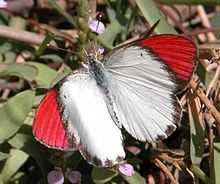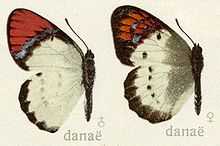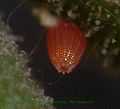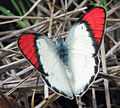Colotis danae
| Crimson Tip or Scarlet Tip | |
|---|---|
 | |
| Male | |
| | |
| Female | |
| Scientific classification | |
| Kingdom: | Animalia |
| Phylum: | Arthropoda |
| Class: | Insecta |
| Order: | Lepidoptera |
| Family: | Pieridae |
| Genus: | Colotis |
| Species: | C. danae |
| Binomial name | |
| Colotis danae (Fabricius, 1775) | |
| Synonyms | |
| |
The Crimson Tip or Scarlet Tip (Colotis danae) is a small butterfly of the Family Pieridae, that is, the Yellows and Whites, which is found in Asia and Africa.
Description
Coloration very variable, especially in the female.
Male

Upperside: white, base of wings generally irrorated, but to a varying extent, with black scales. This irroration in many specimens is entirely wanting. Fore wing: with or without a minute black spot on the discocellulars; apex broadly carmine, edged internally and externally with black, this black border varies in width, but both inner and outer borders meet on the costa and on the termen, on the latter they unite and sometimes extend as a black line to the tornus. Hind wing: uniform, except for a series of black terminal spots, which in some specimens are comparatively large and connected together by an anticiliary slender black line, in others minute, more or less obsolescent, unconnected dots.
-_Male_at_Hyderabad%2C_AP_W_240.jpg)
Underside: white. Fore wing: base of cell washed with sulphur-yellow; spot on discocellulars as on the upperside; apical carmine area of the upperside represented by an ochraceous-pink patch, not margined with black, but similar in shape and position; in some specimens this is more or less suffused with greyish scales; in all, it is crossed near its inner edge by an obliquely placed series of four or five spots that vary in colour from pale ferruginous to black. In some specimens there are two terminal diffuse black spots, one each at the ends of veins 2 and 3. Hind wing: the ground-colour generally lightly, often heavily, suffused with ochraceous pink, sometimes pure white; a small spot on the discocellulars pale ferruginous to black, sometimes annular and centred with carmine; followed by a curved macular discal band that also varies in colour from pale ferruginous to black and has the posterior spots often obsolescent, or even completely absent; a series of minute black dots at the apices of the veins that runs to the termen, and may or may not be connected by a slender black anticiliary line. Antennae pale brown, speckled with white; head, thorax and abdomen black; head and thorax anteriorly clothed with brown, sometimes greyish-black hairs; beneath: palpi, thorax and abdomen white.[1]
Female
Upperside: white; base of wings lightly, often heavily, irrorated with greyish-black scales. In some specimens the irroration is very scanty, in others it occupies fully a third of the wings from base and extends as a broad band parallel to the dorsum on the hind wing. Fore wing: an apical carmine patch as in the male but smaller, sometimes reduced to a mere row of preapical pale rosy streaks, but always bordered externally, and generally internally also, by black of varying width. In some specimens the inner black border is very narrow, in others broad, and in a very few entirely absent. The outer border again in some specimens is inwardly festooned, and may be either broad or comparatively narrow. Discocellular spot as in the male but larger, followed by an anterior, postdiscal, macular, curved, black band, the upper spots of which cross the carmine area, or when the carmine area is reduced to short streaks the band crosses the black internal edging to it, showing up in a darker tint than the edging itself; lastly, a black transverse, somewhat diffuse, spot in interspaces 1 and 2. Hind wing: with a dusky spot on the discocellulars, a black, macular, discal, curved, more or less incomplete band, and a terminal row of black spots that in some specimens are connected and form a continuous band. All these markings are generally diffuse.
_at_Hyderabad%2C_AP_W_171.jpg)
Underside, fore wing: white, suffused with sulphur-yellow at base of cell and with ochraceous (in some specimens ochraceous-grey, in others ochraceous-red on apical area; spot on discocellulars, the postdiscal macular band and spots in interspaces 1 and 2 as on the upperside, but more clearly defined, the spots that compose the postdiscal band sometimes annular. Hind wing: white, suffused to a greater or less degree with, ochraceous, sometimes pink; spot on discocellulars and discal macular band as on the upperside, but both the discocellular spot and the spots that compose the latter more clearly defined, annular and generally centred with carmine; a terminal row of black specks which may or may not be connected by a very slender anticiliary line.[1]
Wing expanse of 45–50 mm in males and 48–52 mm in females and.[2]
Distribution
Baluchistan, western and southern India, Sri Lanka,[1] Mauritania, Senegal, Gambia, Mali, Burkina Faso, Ivory Coast, Ghana, Nigeria, Niger, Chad, Sudan, Ethiopia, Arabia, Somalia, Uganda, Kenya, Tanzania, Angola, Malawi, Zambia, Mozambique, Zimbabwe, Botswana, Namibia, South Africa and Swaziland.[3]
Subspecies
- Colotis danae danae (Sri Lanka)
- Colotis danae annae (Wallengren, 1857) (Malawi, southern and eastern Zambia, Mozambique, Zimbabwe, north-eastern Botswana, north-eastern Namibia, South Africa, Swaziland)
- Colotis danae dulcis (Butler, 1876) (western India and from south-western India to the Persian Gulf)
- Colotis danae eupompe (Klug, 1829) (Mauritania, Senegal, Gambia, Mali, Burkina Faso, Ivory Coast, Ghana, northern Nigeria, Niger, Chad, Sudan, Ethiopia, Somalia, Kenya, to southern and western Arabia)
- Colotis danae pseudacaste (Butler, 1876) (Ethiopia, Somalia, Uganda, south-eastern Kenya, Tanzania)
- Colotis danae walkeri (Butler, 1884) (south-western Angola, north-western Namibia)
Habits, behavior, life cycle
-
Egg Laying
-

egg
-

caterpillar
-
-_Male_at_Hyderabad%2C_AP_W_IMG_7489.jpg)
Male in Hyderabad, India
-
_on_Coat_buttons_(Tridax_procumbens)_in_Hyderabad%2C_AP_W_IMG_7084.jpg)
Male on Coat Buttons Tridax procumbens in Hyderabad, India
-

Crimson Tip at Bangalore, India
-

Crimson Tips courting
References
| Wikimedia Commons has media related to Colotis danae. |
| Wikispecies has information related to: Colotis danae |
